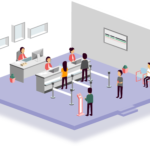Queues. We all know them. We’ve waited in them at the grocery store, hospitals, movie theatres, or even to get coffee. But the thing is — queue management is not just about lining people up. It’s about creating an experience that is smooth, fair, and even delightful. That’s where queue management comes in. Whether you’re a business owner, a manager, or just someone interested in improving service efficiency, this article is your go-to guide on mastering the science and art of queue management. We’ll break it all down: from the psychology of waiting to cutting-edge queue management software, we’ve got you covered.
What is Queue Management?
Queue management is the process of planning, monitoring, and streamlining the flow of people waiting for a service. It’s not simply putting up a sign that says “Wait Here.” It’s the whole plan that can make customers happier and make the operations of your company run more smoothly.
Why Queue Management Matters
Nobody likes to wait. Monotonous or long lines will anger customers and drive them away. That’s bad news for any business. A smart queue management system:
- Reduces wait times
- Improves customer flow
- Increases customer satisfaction
- Boosts operational efficiency
It’s not just about speed — it’s about creating a better experience.
The Psychology behind Waiting
Waiting feels longer when we’re bored, uninformed, or confused. That’s because our perception of time is often different from the actual clock time.
Understanding Perceived Wait Time
Here’s what plays into our perception of waiting:
- Unoccupied time feels longer
- Anxiety makes time crawl
- Uncertainty increases frustration
- Solo waiting feels longer than group waiting
So, if you distract or inform customers, you can make a 10-minute wait feel like five.
Types of Queues
Not all queues are created equal. Here are the most common types:
- Single-Line Queues
Think of a bank or fast-food place. Everyone stands in one line and is served in order.
- Multiple-Line Queues
Grocery stores often have several checkout lanes, each with its own line.
- Virtual Queues
Customers “get in line” through an app or website and wait remotely.
Physical vs. Virtual Queues
Let’s compare the two side-by-side:
| Feature | Physical Queues | Virtual Queues |
| Wait Time Visibility | Limited | Real-time updates |
| Customer Freedom | Restricted | Flexible |
| Accessibility | On-site only | Anywhere with internet |
| Staffing Needs | Higher | Lower |
Virtual queues offer a modern and customer-friendly alternative that can make all the difference.
Benefits of Queue Management Systems
investing in a queue management system (QMS) has some serious benefits:
- Less congestion at service points
- Improved staff productivity
- Higher customer retention
- Real-time data tracking
- Better decision-making
Features to look for in Queue Management Software
Here’s what to look for when choosing queue management software:
- Virtual queuing capabilities
- Mobile app integration
- Real-time wait time tracking
- Analytics and reporting
- Customizable interface
- Customer feedback tools
Virtual Queuing: A Modern Solution
Virtual queuing lets customers:
- Reserve a spot from their phone
- Receive SMS alerts when it’s their turn
- Avoid standing in physical lines
- Use their waiting time productively
It’s convenience in your pocket.
Designing Physical Queues That Work
When virtual queues aren’t possible, smart physical layouts still matter. Here’s how to make them effective:
- Use clear signage to direct flow
- Display wait times with digital screens
- Provide seating for comfort
- Make it available to all your customers
Picture building a miniature traffic system — organized, legible, and flowing.
The Role of Staff in Managing Queues
Humans still crave human contact, even when all has gone wrong.
Train staff to:
- Greet and inform customers
- Answer questions quickly
- Solve problems proactively
- Monitor line behavior
A friendly smile can do miracles for someone who has waited too long.
Data-Driven Queue Optimization
Contemporary queue management is driven by data. The right software can track:
- Peak hours
- Average wait times
- Customer flow patterns
- Service bottlenecks
With this insight, you can schedule staff, redesign layouts, or even adjust service priorities
Engaging Customers While They Wait
Boredom is the enemy of patience. Keep customers entertained and occupied:
- TV screens with news or entertainment
- Interactive kiosks
- Mobile updates or games
- Wi-Fi access
Make the wait feel shorter — or better yet, enjoyable.
Collecting Feedback for Ongoing Improvement
The best queue management software systems include feedback tools like:
- On-site kiosks
- Email surveys
- Mobile pop-ups
Use this data to make changes and show customers you care
Queue System Best Practices
Observe the following steps for a seamless rollout:
- Figure Out Your Traffic, Service Time, and Customer Type.
- Choose the correct system — Select software that aligns with your size and intentions.
- Coach your staff – They must be able to use the system and to help customers.
- Track and adjust – Analyse data on the experience and make adjustments.
Conclusion
The control of queues extends beyond line management because it involves providing excellent customer experiences with efficient operations. Proper management strategies together with appropriate tools and the correct approach enable businesses to convert difficult waiting times into positive customer interactions. The combination of queue management systems and software solutions provides businesses the advantage when they work to improve busy clinics or optimize their coffee shop operations. Take charge of your queues — and watch your customer satisfaction rise.

